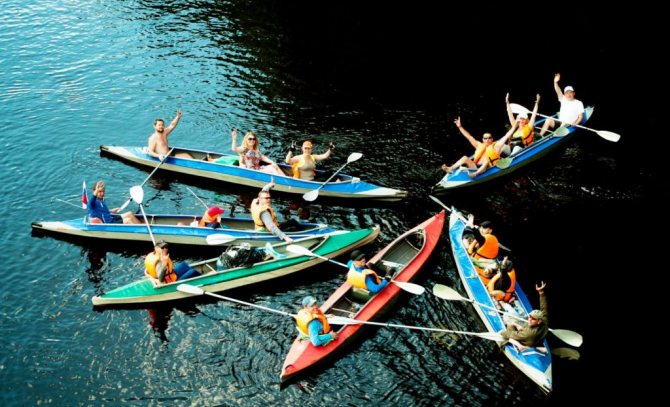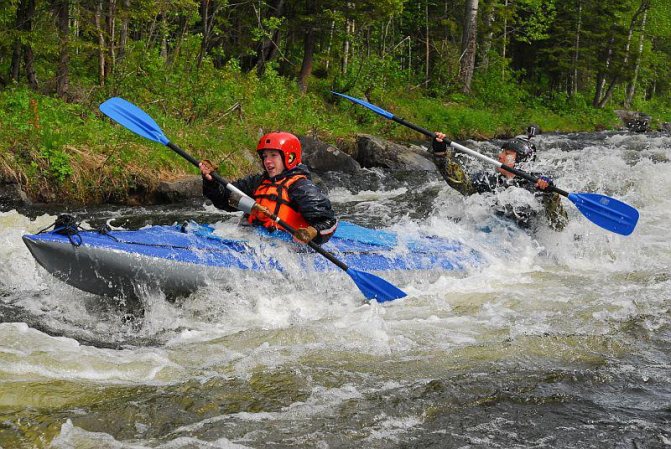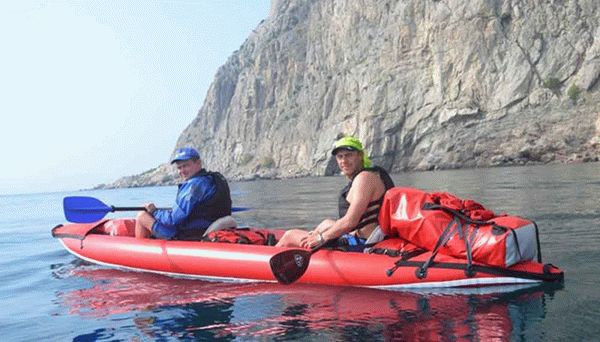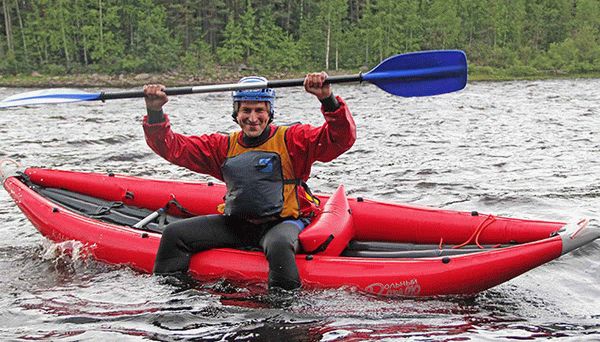Good maintainability
Thanks to the special design of the cylinder shell, they can be easily replaced by one person. A power zipper along the entire length allows you to quickly unfasten it, remove the punctured cylinder and replace it with a new one. Sealing the hole is also easy and does not take a few minutes. It is made with a patch made of the same PVC material, applied to the damaged area without prior drying, treatment with acetone or other degreaser. The patch is placed on the outside. After applying glue to the shell and patch, the surfaces are pressed together for a minute with a damp cloth, and that’s it.
KAYAK CHARACTERISTICS
Like any vessel, a kayak has several characteristics:
- 1. Dimensions
- 2. Stability.
- 3. Unsinkable.
- 4. Mobility.
- 5. Controllability.
- 6. Weight.
- 7. Time and ease of assembly.
- 8. Survivability and maintainability.
Without going into the theory of shipbuilding, it should be noted that all these characteristics are interconnected and any ship is a compromise between them.
A FEW WORDS ABOUT THE CHARACTERISTICS.
1. Dimensions Length, width, side height, draft. Dimensions of a modern double kayak:
- 1.1 Length from 4.5 to 6 m
- 1.2 Width from 0.6 to 1 m
- 1.3 Height from 0.25 to 0.40 m
- 1.4 Draft from 0.1 to 0.2 m
2. Stability The ability of a ship to withstand the action of external forces tending to tilt it in the transverse and longitudinal directions and return to a straight position after their action ceases. Stability is directly proportional to the width and length of the kayak and inversely proportional to the height of the overall center of gravity (kayak, crew, cargo). Stability also depends on the shape of the underwater part of the vessel. The most favorable shape is rectangular, least half circle. When the cargo or crew moves to one of the sides, stability decreases. Conclusions: with equal displacement, the most stable boat will be a short and wide boat, with a blunt bow and stern, the cargo and crew are located at the very bottom. 3. Unsinkability The ability of a ship to stay afloat and maintain its seaworthiness in the event of a hole or flooding. A frame kayak without additional buoyancy tanks sinks to the bottom when flooded. Therefore, when turning over a kayak, when it floats upside down, you should not try to turn it over while afloat. It should be towed to shore and turned over there. To ensure unsinkability, inflatable containers (children's inflatable balls, inflatable toys) are placed in the bow and stern. Frame-inflatable kayaks behave better when flooded (due to the on-board cylinders), but not much. It is possible to control a frame-inflatable kayak that is flooded with water, but it is very difficult. Inflatable kayaks, when completely flooded, remain on the move and are acceptable to control. When turning the kayak upside down, when setting the kayak on a flat calm, almost all the water pours out over the side. With a certain skill, an experienced crew, when turning an inflatable kayak over, is able to turn it back over and climb aboard. 4. Propulsion The ability to develop a certain speed at a given engine power (for a crew kayak). Depends on water resistance and engine efficiency. The efficiency of a kayak engine is a good physical preparation of the crew, correct rowing technique and a good oar. Water resistance consists of three components:
- Friction resistance. At the same speed, the greater the wetted surface of the body and the less smooth the surface, the greater the friction resistance.
- Form resistance. Form resistance increases with irregular contours of the underwater part of the vessel. Due to the shape of inflatable kayaks, the waterline (the line where the hull intersects with the water) is less perfect than a frame kayak.
- Wave resistance. Each ship, when moving, forms transverse waves, bow and stern. The wavelength depends only on the speed of the ship:
Vessel speed, km/h 3,6 5,4 7,2 9 10,8 Wavelength, m 0,64 1,44 2,6 4,0 5,7 When the wave length is greater than the length of the kayak, the wave resistance increases sharply.
Conclusions: the best-selling kayak will be a kayak of maximum length, with sharp waterlines in the bow, a smooth rise of the bottom to the stern, with the smoothest bottom surface, and the absence of large patches. 5. Controllability Course stability and agility are two opposing qualities. A long kayak with a straight keel line and pronounced stems will be stable on course. A short one with a rise in the keel line and tips, without pronounced stems, will spin well, but will not stay on course well. 6. Weight Due to the alloy kit, a frame kayak will be 1.5-2 times heavier than an inflatable one, provided the dimensions are the same. Time and ease of assembly. A frame and frame-inflatable kayak can be assembled in about 40 minutes, an inflatable one in 10-15 minutes. From experience, without the use of profanity and pinched fingers, frame kayaks are not assembled, and sometimes they are not disassembled. 8. Survivability and maintainability. The main dangers for inflatable kayaks are broken bottles and nails in boards on the shore. No one has ever been able to break through an inflatable kayak on the water in front of me. Repair is simple - glue the patch with the necessary glue, for example “moment crystal”. The only way to kill an inflatable kayak is to inflate it until it dings and then leave it in the sun. In this case, the kayak may come apart at the seams. This has happened before on old inflatable rubber boats, but has never been heard of on modern kayaks. In frame kayaks, when they pile up on a stone or log, the skin breaks through. With a strong impact, the stringers and frames may break; if the kayak falls on rocks and overturns, it can be broken in half. Repairs involve sewing and sealing holes, bending pipes, replacing cut rivets with screws, etc. Conclusions: on frame and frame-inflatable kayaks, collisions with stones, logs, pile-ups on rocky or concrete shores, piers, bridges, etc. should be avoided. On inflatable kayaks, if necessary, you can pass over logs, stones, if there are no nails, sharp knots, or metal debris.
Capacity selection
The Chub kayak is available in several modifications in terms of load capacity and capacity. The numbers in the marking indicate the load capacity. Thus, Chub 110, Chub 120 and Chub 130 are a single-seat inflatable kayak, usually used by fishermen and hunters. Chub 140 and Chub 220 – double inflatable kayak; the first is good for weekend hikes without luggage, the second for longer trips. The Chub 330 is considered a 3-4 seater kayak.
This is interesting: DIY kayak
So, taking into account all of the above, we can make an unambiguous conclusion about the fairness of the assessment of users and experts who put the Chub in first place in the rating of inflatable kayaks based on a set of parameters.
What are there
The modern market is able to offer three types of kayaks: frame-inflatable, frame and inflatable. Each type has both advantages and some disadvantages. It is extremely important not to make a mistake and choose a model that would meet a number of characteristics for a specific type of recreation. Often we are talking about leisurely rafting along waterways or fishing in a pond.
It should be noted that kayaks should not be used in areas where there are rocky rapids and raging streams. The recommendation applies only to amateur models. Professional ones are equipped with more effective protection and a durable body. For greater convenience of choice, you should first study the review of popular models and new products from the world's leading manufacturers.
For beginners and short hikes, it is recommended to use inflatable structures. Such products belong to the category of universal ones, so they can also be used for fishing and boating. What could be better than a quiet swim overlooking the picturesque shores on a day off? For such recreation, inflatable structures are used, which are equipped with a durable frame, which consists of two cylinders (onboard).
A special PVC coating of inflatable elements is responsible for strength and wear resistance. In addition to their beautiful appearance, the best models are equipped with protection against aggressive environments, harmful microorganisms, and mold. The advantages of this or that design are given in the comparative table below.
Advantages of using inflatable structures

| Criterias of choice | Description |
| Maximum cross-country ability | They are used not only for leisurely walks, but also for descents along choppy rivers (special models). High-quality products are made of high-strength materials that can easily survive such tests. |
| Sustainability | Contrary to the erroneous opinion of buyers, inflatable structures are very stable on water. In addition, they are easy to operate, which even a beginner can handle. They are used for descending from mountain rivers in all weather conditions. |
| Quick launch | Inflatable kayaks always come with pumps. With their help, you can completely inflate a PVC product in 10-15 minutes. |
| Volume | After use, the product is deflated and rolled into a compact roll, which is then placed in a branded bag. If necessary, the structure can be placed in a tourist backpack or travel bag. |
| Minimum weight | This aspect is extremely important, because the kayak will have to be moved on land. There will be no problems with the inflatable structure, because the weight of the set rarely reaches 10 kg. |
Inflatable kayaks for tourism
Russia has a huge number of rivers suitable for kayaking. Karelia, Kola Peninsula, Southern and Subpolar Urals, Altai Mountains, Novgorod region, Kabardino-Balkaria. Each region has calm waters for a relaxing holiday, and in the mountainous areas there are rivers where you can get a serious dose of adrenaline. Rafting on catamarans and rafts is becoming more and more popular, but kayaks are not losing ground, because they have a number of significant advantages.

Kayak "Harpoon"

The Harpoon kayak is produced. The watercraft has a length of 4.7 meters, a width of 0.85 m, and the weight of the vessel is no more than 16 kg. The cost of the product is from 550 USD. “Harpoon” entered the market back in 2000, and then became a conceptually new product due to the minimum number of frame elements. The vessel is intended for use in fresh and salt water bodies without strong rapids. Calm water is most comfortable for traveling on the Harpoon.
Types of inflatable kayaks for tourism
Tourist kayaks can be classified on various grounds. First of all, by the number of rowers:
Four people for a kayak is the maximum. For a larger number of people, it is better to look for another watercraft, or divide the company into compact crews and take several kayaks for rafting. After all, the main advantage of these boats is speed and maneuverability; here they clearly outperform catamarans and rafts.

Best single kayaks
Such models are intended for single use for tourism or sports purposes. They are small in size and weight, so they can be transported assembled.
Free Wind "Odyssey 370"
4.9
★★★★★
editorial assessment
94%
buyers recommend this product
The reinforced body of the model is not afraid of oncoming snags, stones in rapids and other river obstacles. The kayak does not need to be dried for a long time when going ashore or before storing. Any type of pump can be used for inflation.
The length of the vessel is 3.7 m, the carrying capacity is 170 kg. Features of the model include the presence of self-draining, which makes it easier to navigate difficult sections of the river, rapids, etc. The inflatable stem ensures high performance and safety at high speeds.
Advantages:
- depreciation;
- directional stability;
- high cross-country ability;
- light weight.
Flaws:
- monoballoon design.
The Odyssey 370 kayak is extremely versatile: it can be used for fast walking on still water or effectively negotiating steep river descents.
Stream Khatanga-1 Travel
4.9
★★★★★
editorial assessment
92%
buyers recommend this product
The base of the boat frame consists of one longitudinal element. It combines a keelson, struts in the bow and stern, frames and stems.
Assembling the structure does not require special knowledge or great effort. The closed deck protects the owner and transported items from getting wet.
The length of the kayak is 370 cm, the diameter of the cylinder is 26 centimeters. Special rings and elastic bands located on the deck allow you to securely secure your luggage.
The landing site is equipped with special moisture-repellent skirts, which guarantees its sealing. The comfortable position of the rower is facilitated by the presence of an inflatable seat, a pillow and a soft backrest.
Advantages:
- 4 pressurized compartments;
- increased wear resistance;
- ease of assembly;
- comfortable seat.
Flaws:
- small carrying capacity.
Stream Khatanga 1 Travel is perfect for inexperienced kayakers. It is designed for movement on lakes and rivers with simple rapids and moderate currents.
Stalker "Pike-1"
4.8
★★★★★
editorial assessment
88%
buyers recommend this product
Thanks to the use of cross-shaped struts, the inflatable cylinders are securely pressed against the sides of the kayak. The upper part is equipped with special skirts that protect the deck from water.
All materials used in the design are rot-resistant, which facilitates maintenance and extends the life of the model.
Despite the rigidity and strength of the frame, the boat weighs only 8 kilograms. Thanks to this, it accelerates quickly in the absence of strong wind and is convenient when launching. A flat bottom, a draft of 10 cm and vertical flexibility contribute to stability and comfortable walking near the shore.
Advantages:
- ease of storage;
- high load capacity;
- light weight;
- fast acceleration.
Flaws:
- tedious and time-consuming assembly.
Pike-1 is designed for movement in open water. The kayak is good for solo trips with cargo.
Triton "Vector-1"
4.7
★★★★★
editorial assessment
85%
buyers recommend this product
The long keel length and narrow sides with inflatable cylinders of this boat allow it to develop high speed and maintain directional stability.
There are waterproof hatches at the bow and stern of the kayak, designed for storing personal belongings or hermetic packaging.
The weight of the kayak is 18 kg, the load capacity is up to 150 kg. The rower's seat is mounted on stringers, which ensures reliable fixation of the can. The rigid hull of the boat guarantees protection during collisions or overcoming obstacles.
Advantages:
- directional stability;
- comfortable fit;
- durable body;
- fast acceleration;
- spacious hatches.
Flaws:
- low maneuverability.
Triton Vector-1 will be an excellent purchase for experienced tourists or athletes. An excellent solution for lake or sea sailing.
READ ALSO
15 Best RC Toys
Another basis for classification is design features.
Monobalon models. They are a one-piece structure and are made of reinforced PVC. In a fully inflatable kayak, rigidity and stability are determined by well-inflated cylinders in the sides and bottom of the boat. But bulky cylinders reduce the usable space inside. Large men have a cramped seat and little space for luggage, which means you won’t be able to go on a multi-day hike.
Two-layer structures. These kayaks consist of an outer shell and insertable inner cylinders. These models have a well-defined bow and keel. The boat becomes more stable on the wave, holds its course firmly, and the inflatable sides prevent it from capsizing. But the bottom is usually flat, which prevents it from developing high speed.
This is interesting: How to knit a Kalmyk knot: diagram
Frame-inflatable. For strength, they are reinforced with metal elements. The volume of cylinders is becoming smaller; some manufacturers put two rows of cylinders. For example, Vega-3 from the St. Petersburg company Time Trial.

What types of kayaks are there?
Modern small decked vessels, so popular among outdoor enthusiasts, are distinguished by type and type of construction.
Types of kayaks
Collapsible
A watercraft assembled from metal parts and “skin” - a special fabric stretched over a frame. The kit may include inflatable cylinders, giving the boat greater unsinkability. All parts are stored in a backpack, which allows you to travel on foot, not only by water.
Non-removable
As a rule, it is made of plastic or polyethylene, with a one-piece body, which gives an advantage in the speed of movement through the water. Designed for one rower. Designed primarily for sports, and only then for recreation on the water.
Types
Frame
A vessel with a rigid frame, which determined its name, made of wood or metal. The shell is made of PVC or other waterproof material. Long models are faster. The advantages of frames are their large load capacity and low draft, but this model is bulky, will cause a lot of trouble during transportation, and you will have to spend a lot of time on proper assembly.
Inflatable
Two-layer and single-layer are available for sale. They are equipped with inflatable cylinders, the skin is made of PVC, there is no “skeleton”. They weigh much less than frame ones, are easy to assemble (the main thing is not to forget the pump) and behave well on the water, not afraid of rapids, but they don’t like strong waves, so they can capsize.
Frame-inflatable
A universal invention with a frame and inflatable cylinders. The best option for tourism. If you are going rafting with the whole family, you should think about buying this model: stability, unsinkability, good maneuverability in shallow water - these are the distinctive features of such a boat. However, due to the cylinders, the capacity suffers, and it is a bit heavy. The disadvantages include the long time required for assembly.
Plastic
With die-cast body, durable. You don't have to worry about leaks. Designed for one rower. Fast, convenient, with a long service life, but there are 2 disadvantages: non-dismountable - it is problematic to transport to the rafting site and store, and also impressive weight. But if a big trip is not planned, then a single kayak is what you need for an adventure with water obstacles.
Comparison table:
| Type | Frame | Frame-inflatable | Inflatable | Solid cast |
| Average weight, kg | 30 | 27 | 20 | 35 |
| Stability | Average | good | good | Weak |
| Load capacity, kg | up to 550 | up to 500 | up to 300 | up to 600 |
| Sales rate | good | good | Average | High |
| Internal volume | Big | Average | Small | Very small |
| Unsinkability | Weak | good | Excellent | Weak |
| Price for a new boat, rubles | From 15000 | From 25000 | From 30000 | From 20000 |
Non-reinforced PVC boats
Chinese boats or boats made of non-reinforced PVC are very popular on the world market: they are cheap, light, and compact.
Reinforced PVC, from which boats are made in Russia, looks like this: a dense cord (reinforced fabric) and layers of PVC on both sides. Non-reinforced PVC is different in that there is no cord, which provides the material with tensile and puncture strength. This explains the differences between Chinese boats:
They are light and compact, BUT they hold low pressure and are unreliable against puncture and tearing. Such boats are made on machines without human intervention, using comb welding, the seams of such boats are welded (without glue), thanks to which this technology is being put into production in China and the price of these boats is reduced significantly.
Results on Chinese boats:
This will be one of the best options for you if you need a boat to cross a pond for 5-10 minutes or get game: it will be the cheapest, lightest and most compact when folded, oars and a pump are not needed (you will pump it with your mouth, and cut the oar on the shore). It wouldn’t be a shame to throw away such a boat, and it wouldn’t be hard to carry. Let me give you an example: we have for sale a boat with a carrying capacity of 60 kg and a full set weight of 1 kg. You can’t carry a lot of things in it, but it takes up very little space; the whole boat will fit into your jacket pocket.
